The 10 Best Mold and Mildew Cleaners
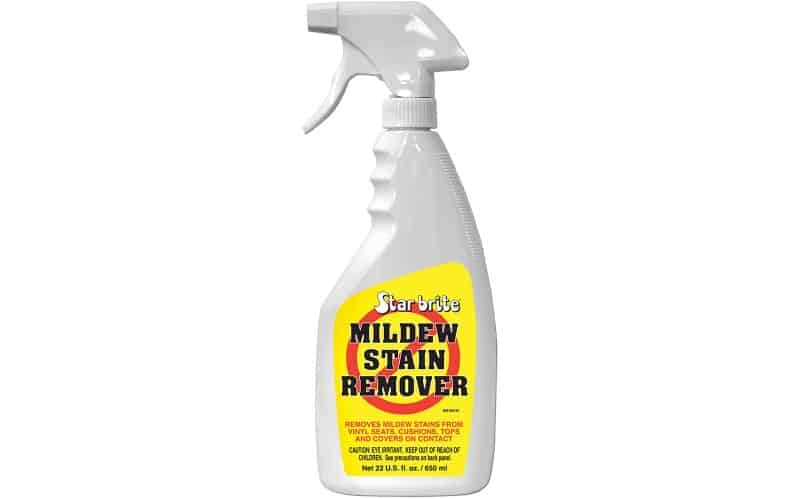
Star Brite Mildew Stain Remover
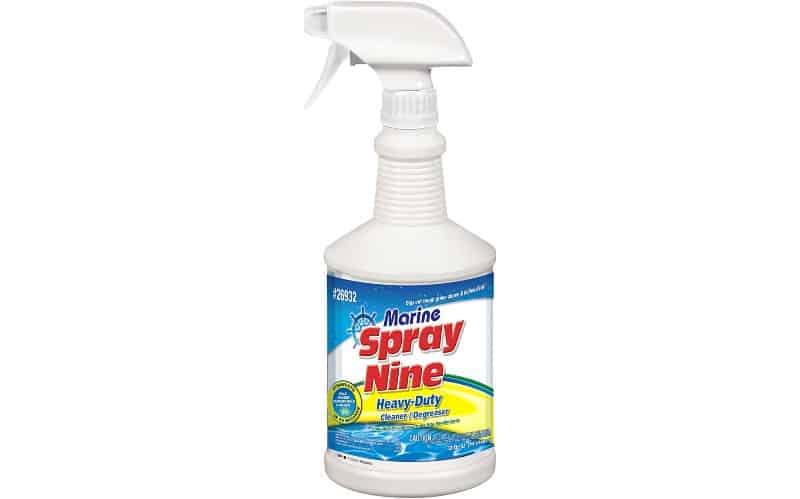
Spray 9 Marine Cleaner

CLR Mold and Mildew Stain Remover
Mildew is the scourge of many boaters. This fungus will flourish in the conditions presented to it on many boats. It needs a dark, damp place with lots of moisture. Poor air circulation and cool temperatures also help. Your fishing boat is a prime breeding ground. Even your carpets and personal flotation devices are at risk. But there are many ways you can fight back. Let’s take a look at the best mildew removers for your boat.
Star Brite Mildew Stain Remover

If you want the best overall cleaner on the market, look to Star Brite. This is a bleach-based formula which means it’s definitely powerful. Bleach is just highly effective at killing mold and mildew. But that means you’ll need to take the proper precautions. Make sure you use this in a well ventilated area. Also, avoid other cleaners. You never want to mix a bleach based cleaner with ammonia. The fumes it produces are toxic. In an enclosed space they could overwhelm you right away. Make sure you’re using gloves as well to protect your skin.
What separates Star Brite from just a bottle of bleach is the formula. This is bleach based but not just bleach. They use what is called a buffeted formulation. That means it’s been designed to be less hard on surfaces. You can safely use this on your vinyl and even the stitching. It’s been designed to not weaken your stitching, which is very helpful. That said, it’s not recommended for use on fabric. You’ll want to avoid getting this on your clothes.
Star Brite is very easy to use and versatile. This is a spray and wait formula. In a serious case you may still need to scrub. But try just spraying and letting it work at first. Give it a good amount of time to soak in. Then use your sponge to wipe it away and see how it looks.
The formula is safe for most surfaces on your boat. Fiberglass, vinyl, even painted surfaces and rubber. We recommend you saturate the area and wait ten minutes for it to soak in. Then, when it’s done, spray the area clean first. If you still have stubborn stains, reapply the cleaner. Then, on this second pass, try scrubbing to finish the job. Then spray it clean again. Stubborn mildew stains should now gone by then.
Just remember, the smell can be intense. If you’re cleaning down around your bilge or in a tight space, keep those vents open. Take regular breaks, too. If you’re feeling light headed, give yourself a few minutes. That goes for any cleaner on our list. Don’t make yourself sick just to cut through some mildew.
One thing to remember about Star Brite is that it doesn’t prevent mildew. Once you clean up, you should apply another product to treat your surfaces and prevent new mildew.
Star Brite is one of the more affordable options you’ll find. Combine that with the fact it’s also one of the most powerful and this should really be your first choice for most mildew cleaning.
Spray 9 Marine Cleaner

Marine Spray Nine Heavy Duty is a tough product. This is an ammonia based cleaner and it is not messing around. There’s a reason so many boating magazines and others have ranked it number one. It’s powerful and it’s effective. The price is also pretty reasonable.
It’s not just mold and mildew this product can eliminate. It’s also an effective degreaser and disinfectant. In fact, in addition to killing a couple of kinds of fungus, this makes short work of many other harmful things. For instance, let it sit on a surface for just 45 seconds. When it’s done you will have effectively killed 14 kinds of dangerous bacteria. That includes, e.coli, salmonella, staph and strep, listeria and bordetella.
In just 30 seconds this formula will also destroy over 15 kinds of viruses. That is including flu strains.If you want something as clean as it can possibly get. Spray Nine has your back.
The formulation is an ideal stain remover for boat seats. It’s also great on several hard surfaces as well. You can clean up everything from your hull to your life jackets with this.
For most stains the process is very simple. Spray it on and let it soak in according to directions. Then use an old rag or sponge to wipe it away. In most instances scrubbing shouldn’t even be necessary.
After a thorough cleaning with Spray Nine, surfaces do seem to have solid protection. Some people even report surfaces clear from mildew for up to a year afterwards. That’s a pretty good result.
The smell of this stuff isn’t necessarily all that great. But it’s not as harsh as some bleaches, either. So just be aware that, as always, you’ll want ventilation when you’re using it.
One thing you might want to look into is the label here. Many other uses have said that this marine formula and the regular Spray 9 formula are the same thing. If that’s the case, you may save a few bucks just buying the regular stuff. This is really a great overall product, though. If you can’t find the marine version, Spray 9’s normal mildew remover should get the job done for you.
3M Mildew Stain Remover
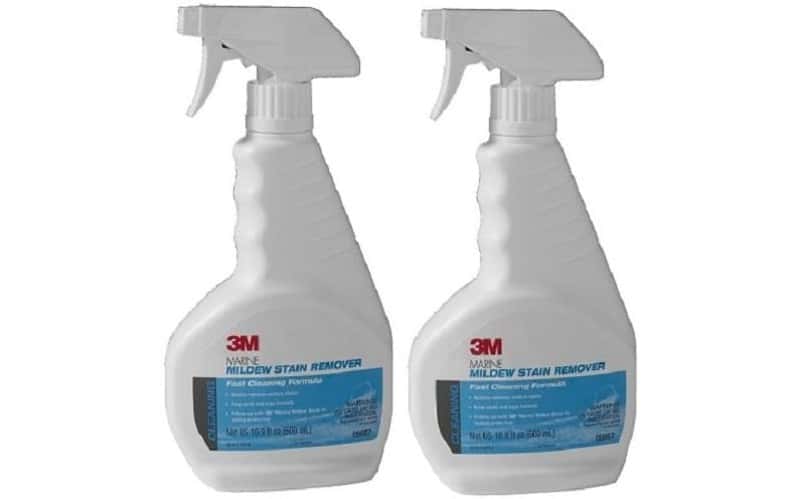
This one may not look like much, but 3M has never been about flashy labels. The product, however, is hardcore. This is a bleach based formula and it definitely is bleach heavy. There’s more inside though, including something 3M lists on the label as a trade secret. Take from that what you will. We don’t know what it is either, but we can tell you it works. 3M’s mildew stain remover will cut that mildew down to size.
One thing you need to be aware of is that this stuff smells intense. While it is a mixture of chemicals, bleach is all you’re going to smell here. In an enclosed space it gets overwhelming fast. Not only do we recommend good ventilation, this might be best with a mask. It can irritate your eyes, noses and throat pretty quickly otherwise.
The other thing to look out for is how this works in the sun. Many of these cleans are affected poorly by a hot, sunny day. This one is no different. We’d recommend waiting for a cloudy day or finding some shade, if possible.
In terms of use, this one is a breeze as well. Spray on and wipe away with a rag. If you have a serious stain, you’ll want to let it soak. Give it up to ten minutes and then try scrubbing with a soft brush. Wipe and rinse and see how it looks.
This is best for things like vinyl and fiberglass. You want to avoid this on cloth and carpet. Wood and painted surfaces won’t work well with this product either, so keep that in mind. They also recommend avoiding exposure to metal and porcelain. So keep that in mind while you work, as sometimes cleaners can run from one surface to another.
CLR Mold and Mildew Stain Remover

CLR is a popular household cleaner. The name stands for Calcium, Lime and Rust. It’s great for cleaning sinks, coffee pots, all that kind of thing. But their mold and mildew cleaner is an excellent choice for boats. Normally we wouldn’t recommend too many non-marine specific cleaners for this job. But CLR’s formulation is both safe and effective. It is a bleach free cleaner which means you won’t have that harsh bleach smell here. In fact, CLR is part of the EPA’s Safer Choice Program. That shows consumers products that use chemicals that are not as harsh and dangerous.
CLR is incredibly diverse and versatile. You can use this on almost any surface. They recommend testing it discreetly before trying fiberglass, however. That’s why this is not a marine-specific cleaner. That said, many people have had a lot of success using this on their boats. We can’t say for sure it’s 100% safe, however. If the company said you should test it out first, we have to take their word for it. But for us, and others, it seems to work great on fiberglass. Just be aware and follow precautions first, just in case. They don’t say not to use it on fiberglass, just to try it first.
Fiberglass aside, you can use CLR on wood, painted surfaces, fabric, glass and more. They caution against stainless steel. And they also recommend you use gloves and a mask when cleaning. Also keep the area ventilated. But that’s our advice for every cleaner as well. It’s a good habit to get into at any time.
In terms of application, spray CLR on the stained area.Give it about 10 minutes to do its magic. Then wipe it clean with a dry rag. There is also a foaming formulation you can try if you want. This one may be better for tougher stains. The foam sticks in place so it is able to saturate the stain better. It depends on your preferences, really. The formulation seems to be mostly the same.
If you hate the smell of bleach in other cleaners, CLR is a great choice. You can have some peace of mind knowing it is environmentally friendlier than some. It may cost a little more but that really pays off in the long run.
Boater’s Edge Mildew Stain Remover
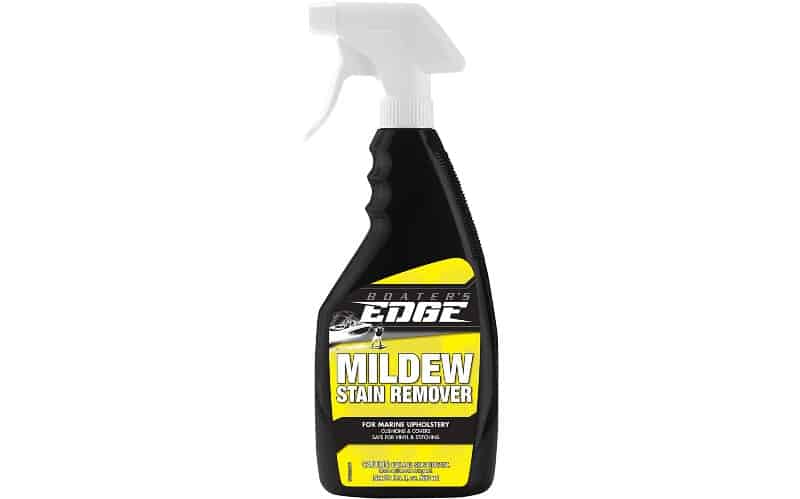
Boater’s Edge mildew stain remover is a solid choice. Don’t let the label fake you out, though. It says it’s designed for upholstery. That may make you think it’s limited in function, but that’s not the case. For whatever reason, the company chose to only highlight the fact it’s good for upholstery. That means your vinyl and stitching can handle the cleaning. But it’s also very effective on many other surfaces.
You can safely clean fiberglass, tile, plastic, and more. Amazon says it’s safe to use on wood but that is not actually correct. You could use it on wood or painted surfaces, sure. But only if you plan to paint them afterward. That’s something worth keeping in mind.
This is another buffered bleach formulation. That means it is bleach based and it could damage fabric. However, it’s designed to not harm things like thread and stitching. It should still be used with the same caution you’d employ with other bleach cleaners. Keep those vents open and get plenty of air. Consider gloves or even a mask if in an enclosed space.
Like other formulas, this one advertises a simple clean up. Spray, let it eat away the stain, then spray clean. But you may notice that one application is not enough. A bad mildew stain will likely withstand a single treatment. That means you may need to go in for round two. In that case, treat the spot again. Then use a dry, soft-bristle brush. Scrub the spot lightly and see if you can get the stain to come clean. Rinse again and see how it looks.
For most stains it should power through them pretty easily. Just be aware that you may have to put in a little extra time with this one.
Star Brite Mildew Stain Remover Gel
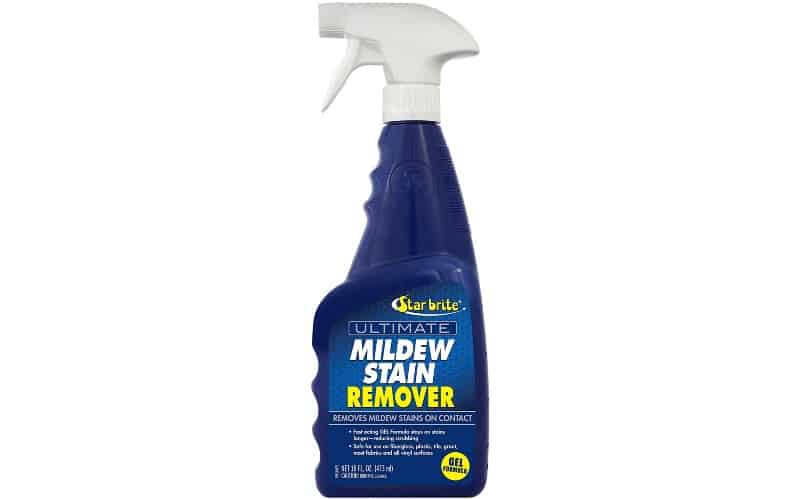
Star Brite is back for its second appearance. Why Star Brite again? This is a slightly different product. It’s good enough at what it does that we thought it was worth listing. This is their Ultimate Mildew Stain Remover gel formula.
Like others, this is a buffered formula. You can confidently use this on vinyl, fiberglass, plastic, even painted surfaces. The big selling point for this one is the consistency. It probably cleans as well as the original Star Brite formula we mentioned. But as a gel it can potentially be much more effective.
If you have serious mildew stains, this is a great choice. Or if you have them in awkward spots, like up on walls or even the ceiling. Because this is a gel, it holds fast. You can apply it literally anywhere. It won’t run and drip like most other cleaners. Because it holds its position it can soak in no matter where you need it. That may not be a big deal all the time, but it is sometimes. And when you need a cleaner for an awkward spot, you’ll be glad you have this handy.
Like the other Star Brite formula, application is easy. Spray it on and let it sit. If you have a serious spot to clean, you may need a brush for scrubbing. Get into those hard to reach spots as best you can. Then, when it’s all done, rinse away. It’s easy and pretty quick overall.
Take caution with this formula, however. The smell of this is pretty strong. And, since it’s gel, it sticks. If it gets on your clothes or your skin, it can cause some damage. So even more than the other products, be smart about using this one. You must have good ventilation before using this.
Concrobium Mold Remover
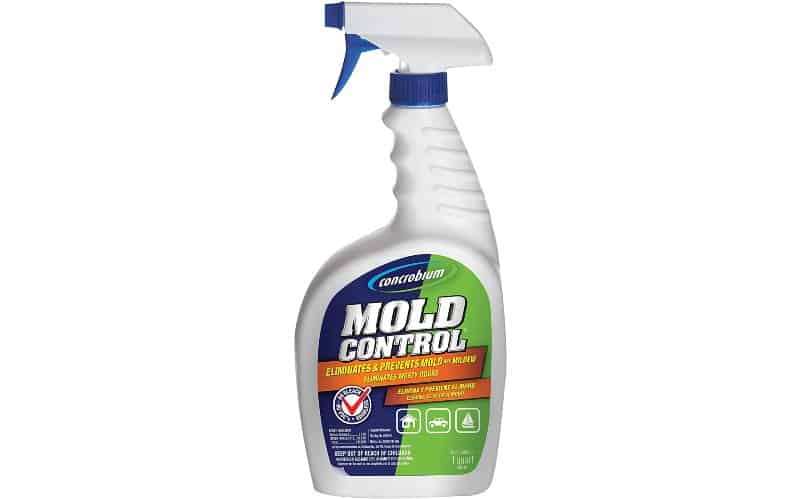
Concrobium is a good product for light mildew stains. It’s also good if bleach cleaners really bug you with their fumes. This is a non-bleach cleaner. They also advertise it as odorless and that’s basically true.
The formula here is sodium carbonate and TSP. Both of those are pretty common cleaners that are not as chemically harsh as bleach. TSP is not necessarily something you want on your skin, however. And it can be damaging to the environment in large amounts. But the amount in this cleaner is very low.
One thing to be aware of is how this works. You spray it on mildew and let it dry. If you scrub or rinse it away, it won’t work. What happens is, as it dries, those chemicals in it crystalize. They literally crush the mold as it happens. When fully dry, the crystals will shatter the mildew and you can wipe it all away. But you need to follow those directions!
If it isn’t allowed to dry fully, it won’t work. This includes if you use it in a place that’s just too humid or damp. Keep that in mind. But if it is allowed to work properly, it’s actually remarkably effective. And far less harmful than many other chemical cleaners.
One of the best things about this cleaner is the after effect. It will prevent mildew from regrowing fairly effectively.
Lemocide
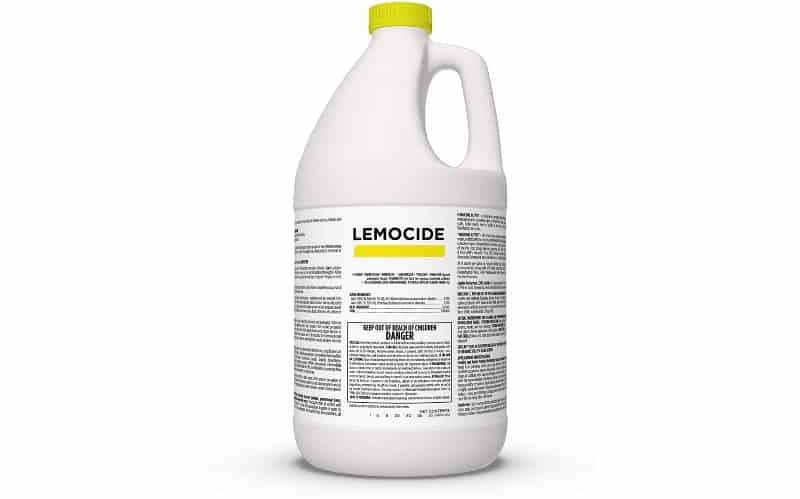
Sick of awful chemical smells? Lemocide can take care of that for you. Aside from being effective at eliminating mold and mildew, it has a lemon scent that is much less harsh.
Lemocide is an industrial grade cleaner. You wouldn’t need to buy this for any small cleaning job. But if you have a lot of mildew to power through, consider it. If you just bought a new boat that needs a real solid overhaul and cleaning, this may be what you need. This stuff is used in schools and hospitals to kill mold, viruses and bacteria. It can stand up to most tough jobs with ease.
Definitely make sure you follow directions closely. You need to dilute this with water before use. It goes 64 parts water to one part cleaner. You don’t want to mess with this cleaner because it can be dangerous if used importly. Keep things well ventilated and use gloves.
This will kill mold and mildew pretty much on contact. Then you’ll need to rinse or wipe it away when done. When used as directed it’s highly effective. The formula is used in industrial settings including in agriculture. That means it’s safe to use if you have pets. Just make sure you follow directions for cleaning up. It’s still something you don’t want to breathe in or get on your skin too badly.
The company offers a 30-day money back guarantee on the cleaner as well. That’s not something you’ll see from most cleaners, so it’s a nice touch.
Earthworm Mold Treatment

Earthworm is another product designed with safety in mind. It cleans by way of natural enzymes rather than harsh bleaches. It’s also free from fragrance, so if smells bother you maybe give this a try.
Shake the bottle before you use it. Unlike some, this one seems to need a good jolt to mix it properly. Spray the surface you’re cleaning and let it sit for about 5 to 10 minutes. You can use a soft brush to scrub it after that time. The enzymes can continue working even after that. If you have a tough stain, it may take a while to power through. A second application can be used if you have severe mildew stains. But one application should get the job done for you. Just rinse it off and start again if you need to, though.
The fact it’s environmentally friendly is a big selling point here. And the lack of odor is also nice. Still, make sure you use it in a well ventilated area. That’s just a good habit to get into. Because it’s not a harsh chemical it’s safe to use on a lot of surfaces. You can even clean mildew off of carpets with this.
Don’t expect this to be as powerful as some bleach cleaners. You’re likely going to need to give the surface a good scrub after using it. But it should be good for some lighter mildew stains.
Nautical Ease Biodegradable Boat Cleaner
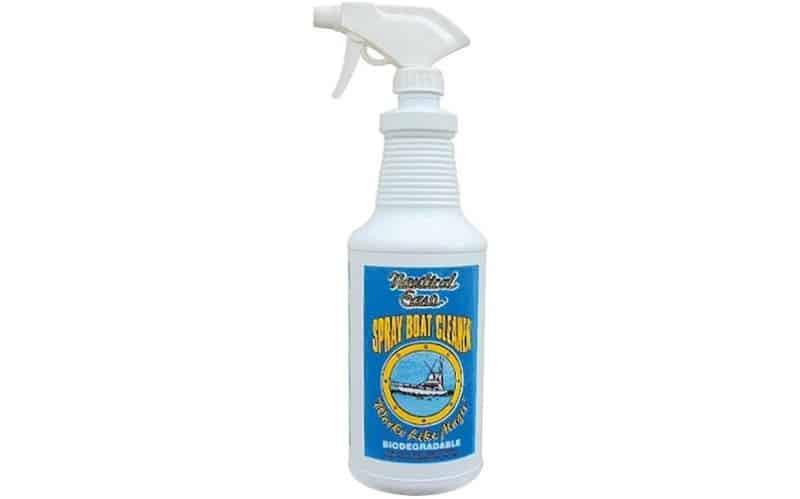
Nautical Ease has a biodegradable formula. That’s for if you’re worried about the environment, and you should be. You should take every step to avoid any cleaner getting in the water. But if it does leak out a little, it’s best to be environmentally friendly.
This brand is a little pricier than some. But it can offer results to match the price. It’s a solid choice for dirt, grease and mildew as well. The formula is safe for many surfaces including vinyl and fiberglass. It’s also safe for aluminum and stainless steel. Be aware that this is not recommended for anything with a porous surface, however,
When using on mildew, you’ll want to let it sit for a short while and then scrub. It may take a couple of applications. We also recommend wearing gloves. Non-toxic though it may be, it can cause a reaction. You’re better off being cautious, just in case.
It can take a bit of elbow grease to get this to work. You may need to scrub a bit harder, but the results do look pretty good. And it handles vinyl really well. Just be careful with older materials. If you have stiff, old vinyl this may make it look a little off when you’re done.
For new or light mildew, this is a great choice. Often all you’ll need is to let it rest a minute or two, then wipe away. Another thing to watch out for is sunlight. If you’re cleaning on a hot, sunny day it may cause this stuff to work faster and dry faster. You’ll have to match that speed in the sun, if you’re not careful.
The final clean dries to a nice looking shine. It will also protect against the return of dirt and mildew as well. Overall, this is a solid choice for a non-toxic and biodegradable cleaner.
Why is Mildew an Issue?
So you see mildew creeping up everywhere, but what’s the big deal. Obviously getting rid of it is a major industry, but not everyone knows why. There are a couple of reasons why you want to get rid of that mildew on your boat.
Mold and mildew are often confused but they are not always the same. Functionally, the difference likely doesn’t matter to a boater. But technically they are sometimes different things. Mold is often fuzzy or slimy and is raised up. Mildew is usually flat to a surface. It is often powdery if you try to wipe it away. In very moist conditions it too will be slimy, though. Usually mildew is grey, black and/or white with perhaps a hint of brown or yellow. Mold can be black, green, orange, red, even blue sometimes.
Mildew tends to smell musty. Think of the washer on a hot day if you forgot to empty it. Mold will smell much worse, even sour. Many molds produce more by-products that have a pungent smell compared to mildew.
Mildew is a kind of mold, so it’s fair to use either word. But while all mildew is mold, not all mold is mildew.
It’s Ugly
Let’s not mince words. Mildew looks bad. It’s a dark sludge layer. It makes your once clean and probably expensive boat look like it’s uncared for. We associate mold and mildew with unclean and junky things. That’s not the image you want to portray with your boat.
It’s Dangerous
Mold and mildew can lead to health issues. Fungi like mildew reproduce by way of spores. They release these little spores into the air and you can breathe them in. For some people this causes respiratory issues. If you already have breathing issues, like asthma, mold and mildew can make them worse. In addition, they can cause allergic reactions.
It’s Damaging
Mildew on the hull of your boat may never destroy that hull. But what if it spreads? Mildew can cause certain materials to degrade and deteriorate. The stitching in your upholstery is one of the most vulnerable things on your boat. After that things like awnings, lines, canvas, and so on. The softer a material it is, the more likely it will be to degrade. Over time, the stains and discoloration will be harder and harder to remove. And eventually, these things will fall apart.
Choosing the Best Boat Mildew Stain Remover
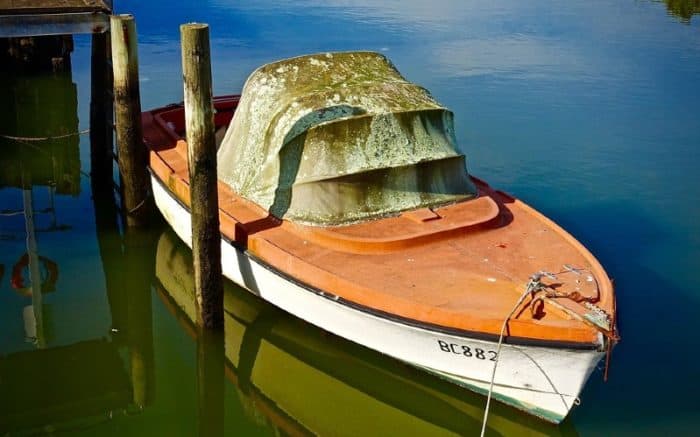
You have a handful of factors to consider when looking for the best mildew remover. They are, sadly, not all created equally. These are some of the things to keep in mind with mildew stain removers.
Speed
Few people in the world actually enjoy cleaning. You want a product that works quickly. But when it comes to mildew, you often need to strike a balance. It can be hard to remove. That sometimes means you need patience. Some cleaners take a while to really work on the mildew. Keep that in mind as you go. Rarely do you squirt a cleaner on and wipe it clean a moment later. This could end up being an all day kind of job. Be aware of how much time you need to do the job right.
It’s a good idea to always check online reviews about this. If a cleaner seems too good to be true, see what other people say. If the product says it can clean with no scrubbing in just five minutes, find out what real users have noticed. If most of the reviews say it’s not that good, then you may not want to risk buying it at all. But if the majority of users agree that it’s a great product, you can be more confident in trying it yourself.
We’ve tried to recommend a good balance of products. Things we feel balance power and speed.
Chemical Make Up
We’ll get into this more shortly. But for now, you’ve already seen there is a difference in chemicals used. This is very important. It can have an effect on your health and the health of your boat. Not to mention the environment as well. We recommend using only marine-approved cleaners. You don’t want dangerous chemicals getting into the water if you can avoid it. A mildew remover for boat cleaning should be environmentally safe.
You need to consider your own health as well. Some harsh bleach cleaners can damage your skin and lungs. Make sure you are working in a well-ventilated area any time you’re removing mildew stains with chemicals. Inside of a boat, this can become risky. A tight space with bad ventilation can become overwhelming. Be safe and cautious at all times.
Versatility
You want mildew remover brains than can handle every part of your boat. This is harder to find than you might think. Mildew can form on almost anything. And it can form next to almost anything. So your mildew remover could be getting on things like:
- Aluminum
- Plastic
- Fiberglass
- Wood
- Rope
- Stitching
- Canvas
Think of how many normal cleaners can handle all of those surfaces. There aren’t many. Harsh cleaners full of bleach are good on some of those surfaces but not all. So you need to make sure what the mildew remover brands are safe for. Use caution around surfaces that you’re not sure about. When in doubt, either test a small portion or avoid it entirely.
Be especially wary of paint. Unfortunately, many mildew removers react poorly with painted surfaces. Part of this is due to how mildew damages the paint itself. It’s very likely that if you clean mildew off a painted surface, your work is just beginning. You may have to repaint those surfaces once everything is clean. Check the instructions on whatever product you buy to be sure ahead of time. And even then, if the mildew was bad enough, it may be a situation you can only fix by repainting.
Keep in mind, painting over mildew is rarely a good idea. Sometimes it seems like it could be easier. Why clean it first, right? Well, it’s usually a good idea. Mildew is a living thing. It produces by-products that can seep out and ruin the new coat of paint. Plus you may be able to see the mildew through the new paint anyway. Clean first, paint after.
Upholstery Cleaning
This one gets its own special mention. Cleaning the seats on your boat is a hassle. It can be a much bigger chore than the hull or the deck or wherever. Oftentimes, the material of a boat seat is textured. You may not even notice until the mildew appears. Then, when you’re cleaning, you notice all these little holes and divots. Just a tiny bit of texture now filled with mildew. As you scrub, it seems impossible to get the mildew out of those tiny little divots.
This is why you need to make sure your products works with the material of your seats. You may need to let it soak in. If scrubbing doesn’t work, you may also need a pressure washer. A low pressure blast, one that is not strong enough to damage the material, may finish the job. But it’s hard to know for sure because of the variables. You may have to try a little experimentation if things are difficult for you. Hopefully, though, some of our recommendations will come through for you.
Ease of Use
Some formulas are much easier to use than others. That’s a good thing 90% of the time. But there are occasions when you may need a more complicated product. That means something you need to mix yourself, or a product you have to let sit. Ease of use isn’t always the best thing but obviously it is most of the time.
Some products have a simple spray bottle. You squirt the product onto the mildew and that’s it. You may need to scrub but some claim to be scrub free. Often this depends on the nature of the mildew more so than the cleaner itself. But either way, sometimes mildew cleans can be very simple to use. Ideally you want a product that is both quick and efficient.
If you ever had to clean a boat 20 years ago versus today, you know how far cleaners have come. Time was that most of the work was done with your arms and a scrubbing sponge surface. So any edge you can find to prevent that non-stop scrubbing is a welcome one.
Additions
As we’ve seen, there are numerous formulas for combating mildew. Some will only combat mildew, some can prevent it. A cleaner that is able to prevent future mold and mildew is obviously ideal. This means you don’t need to buy that second mildew preventing product.
It’s also worth looking into what the product contains. Does it have a harsh chemical smell or was something added to improve the smell? Likewise, can it cut mildew odor with deodorizers? Check to see what was added to the formula and if it meets your needs.
Consider Mildew Prevention as a First Line of Defense
It’s not super helpful to say this, but the best way to fight mildew is to prevent it. Avoiding it is easier than fixing it. That’s true for everything though. There are steps you can take to avoid mildew that should limit your problems down the road. These include things like:
Store Your Boat Properly: When it’s time to pack up for the season, do it the right way. Make sure you have thoroughly cleaned and dried the boat. You want it going away as clean and dry as possible. Make sure you have it sealed against moisture as well as you can. Store it in a place that is moisture controlled if possible. If not, do your best to make sure it’s not going to be exposed to rain, snow, or condensation.
Keep it Ventilated: Air flow is a great tool to fight mildew. Mildew likes to grow in stagnant damp places. That’s why the bilge is such a problem spot. The wetter a place is, the more likely it is to grow mildew. Make sure you have proper ventilation on your boat. It’s good for preventing more than just fumes building up. Keep the bilge blowers working well at all times. If you’re finding you have problems with fumes there are solutions. Same with condensation. You should consider changing your vents.
Keep it Dry: Sometimes a boat is built in a way that just seems to trap moisture. Even when you’re cooking a meal you’ll see moisture forming on the walls and windows. If that’s the case, consider a dehumidifier. Small, portable unit can be used when you’re docked, or even on the open water. Use them in enclosed spaces to prevent unwanted moisture build up.
Treat the Boat: There are some products available that are not just cleaners. These are also used as preventatives. These can help stop mildew from coming back after you use them to clean older mildew stains. Likewise, you can use them even before mildew forms so you don’t need to clean it later. There are a variety of marine sealants that are designed to inhibit mildew growth. Just be aware that these are rarely 100% effective. They can greatly slow mildew down, but it may yet return if conditions are ripe. Your best bet is to use a product like this in conjunction with these other methods. Combine it all together and you will likely have very little mildew to deal with. That means any clean up will be much easier to manage.
Caution: There are products you can buy that can be very dangerous. The active ingredient in products like DI-GAS or MIL-DU-GAS is paraformaldehyde. Marine versions of these chemicals can be used. Still, we recommend against them if not entirely necessary. Non-marine versions should NEVER be used. The fumes can be deadly in the enclosed spaces on a boat. DO NOT USE THESE PRODUCTS ON YOUR BOAT.
Things to Remember About Mildew Stains
Mildew is a living thing. For that reason, it can be unpredictable. Spores from mildew can start growing in as little as one day. One day from no mildew to a little colony of the smelly, green and black sludge. Cleaning it is often a constant battle on boats.
The more harsh the cleaner you use, the better luck you’re going to have. But of course, that is often a problem as well. On a boat, you want to use the least harsh products you can, ideally. Contaminating water with chemicals is never something any boater should want to do.
The First Method
We recommend trying the easiest method first. When you see mildew forming, try to remove it with a sponge and some warm, soapy water. Oftentimes this can actually get the job done. Especially if the mildew is fairly new. If it hasn’t had time to really build up and set in, it can be easily removed. If you’re diligent, you may never even need more than this.
The Second Method
Of course, it’s often never that easy. That means you’ll need to graduate to more complicated methods of cleaning. If you find soap and water isn’t getting the job done, try white vinegar. This is another environmentally friendly method that costs barely anything. Put white vinegar in a spray bottle, and saturate the mildew area. The acid in vinegar is a very effective cleaner. Let it soak in for a while, then try again with your warm soapy water and a sponge.
The Third Method
At this point, if things haven’t worked yet, take a moment. One of the cleaners we’ve recommended will be something you should look at. Old mildew is often harder to clean than fresher mildew. In this instance, try to find a cleaner that is non-chlorine based. These include cleaners that use chemicals such as:
- Hydrogen peroxide
- Ammonium chloride
- Natural enzymes from plants
Many cleaners that use these as a cleaning base are available. We have recommended the ones that we think are the best. The ones that had the most success, in our experience, cleaning mildew. Be aware, however, that these are going to be less effective than chlorine cleaners. That’s just a fact when it comes to me. Chlorine-based cleaners, and by that we mean bleach, tend to be the most effective. The problem is, however, that bleach is a very harsh substance. It’s usually bad for softer fabrics and materials on your boat. It could be dangerous if it gets into the water, it’ll also be bad for your skin. Not to mention that if you use it in an enclosed space, the fumes can be dangerous.
There are some cleaners on the market that claim to be as effective as bleach but are non-chlorine based. Always make sure you check those reviews of the product first. Many of them have proven to be very ineffective when it comes to cleaning things like mildew. Some of them can be quite expensive as well.
The Final Method
But all else fails, bleach based cleaners may be your best and only option. There are numerous bleach cleansers on the market. The percentage of active chemical (sodium hypochlorite) will differ from one to another. Some can be up to 96% sodium hypochlorite. This is extremely harsh and should be used with caution.
Never use these bleach cleaners on things like fabric or stitching. Not only can they strip color, they weaken the material. If left to soak in, they could break down and destroy stitching as well.
Don’t Forget: For things like rope, you may be at a loss. Should you use chemical cleaners on dock lines? And even if you do, how do you get into the cracks and fibers? It’s nearly impossible to clear mildew off of these things completely. Not with normal cleaning methods. We recommend using a less damaging method to start. When it comes to things like halyards, dock lines and awnings, try water. Specifically, a pressure washer.
We recommend against a commercial pressure washer. Those use enough pressure to cause serious damage. But try a low pressure blast with a regular washer to start. Adjust the pressure up as needed. A few passes should be enough to clear off dirt and mildew.
Be Aware of Materials
Mildew can form just about anywhere on a boat. That’s one of the more annoying traits that it has. And that often means you will need more than one approach to clean it. Mildew on wood or fiberglass may need to be cleaned differently than mildew on canvas. Things like sails or upholstery are often not able to stand up to harsh cleaners as well as the side of your hull will. Always make sure you read the directions for any product you buy. If it recommends spot testing before fully cleaning, make sure you do so. And if it says not to use it on certain kinds of materials, it’s best to follow those rules. The last thing you want is to be trying to clean mildew off of vinyl boat seats. That could cause a chemical reaction that burns a hole in them.
The Bottom Line
Mildew makes a boat look bad. It also makes the boat dangerous for your health. And the thing about mildew is that if you give it an inch, it takes a mile. Mildew that is allowed to flourish grows and spreads rapidly. One ugly spot becomes two and then four and so on.
Cleaning is a hassle but it’s part of boat ownership. The rewards for making sure your boat stays clean and mildew free will be obvious. It’s better for you, better for passengers, and better for the boat. Just make sure you’re using the best product for your needs.
As always, stay safe and have fun.
Categories: Boats, nauticalknowhow












1 Comment
Dalton Bourne on August 3, 2022
Bought a neglected, used boat here in Florida. Tried to salvage the vinyl upholstery from the mildew and stains but bleach, vinegar, etc., was not working. I found this mildew remover for the boat seat and figured it would be my last-ditch effort to salvage the upholstery. AMAZING! The secret is patience. Give it time to work. I sprayed the Star Brite on the cushions and waited until the discoloration was gone. Granted that some areas required more than one application, the stains are gone.